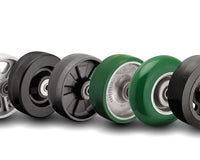Swivel Rigs
When it comes to racks, carts or other items that are frequently moved around facilities, it’s a safe bet that they include swivel casters. Think of a shopping cart – the two casters at the front of the cart are swivel casters, which allow you to easily turn the cart. The wheel in a swivel caster is usually offset from the vertical axis of the caster to enable the wheel to follow behind the direction of movement. Swivel rigs are available with kingpins, or kingpinless design.
Swivel casters with a kingpin include a rivet or nut & bolt that ties the fork to the top plate, but still allows the rig to rotate. Kingpins allow slightly more ‘give’ in the caster’s assembly, which can lead to a shimmy and increased wear in the caster. The kingpin is also a common point of failure in swivel casters, so it’s important to keep load capacity and how your cart is being moved in mind when choosing a caster with a kingpin
.
For heavier loads or use of powered equipment, kingpinless casters are a better choice. On kingpinless casters, the yoke and top plate are tied together with a single race of ball bearings. This eliminates the need for a kingpin, making these casters less likely to fail while also helping to reduce caster ‘shimmy’.
Learn more about the differences between traditional and kingpinless casters in this technical article.
Rigid
Rigid rigs hold the wheel in a stationary position so it can not change direction, limiting the direction of movement to a straight line. Staying with the shopping cart example, the rear wheels of the cart are rigid. They help maintain the orientation of the cart. If all four wheels swiveled, the cart would be very hard to control, especially with a load of groceries. If all four were rigid, it would be nearly impossible to turn the cart.
Since there are no moving parts in the rig due to no bearings or a kingpin, the rig is virtually maintenance free.
Choosing the correct rig depends on the specific application. If you’re looking to only move things in one direction, a rigid caster would work best. For carts, racks or other things that need to be able to turn, swivel casters – with either a kingpin or kingpinless design, depending on the load – are necessary. Need help choosing the correct caster? Reach out to us. Our experts will help you find the right caster for your needs.




